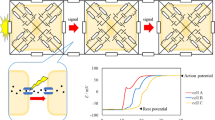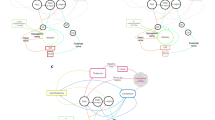Abstract
It is well known that neuronal firing properties are determined by synaptic inputs and inherent membrane functions such as specific ionic currents. To characterize the ionic currents of brainstem cardio-respiratory neurons, cells from the hypoglossal (XII) nucleus and the dorsal motor nucleus of the vagus (DMX) were freshly dissociated and membrane ionic currents were studied under whole-cell voltage and current clamp. Both of these neurons showed a TTX-sensitive Na+ current with a much larger current density in XII than DMX neurons. This Na+ current had two (fast and slow) distinct inactivation decay components. The ratio of the magnitudes of the fast to slow component was roughly two-fold greater in DMX than in XII cells. Both DMX and XII neurons also showed a high voltage-activated Ca2+ current, but this current density was significantly greater (three-fold) in DMX than XII neurons. A relatively small amount of low-voltage activated Ca2+ current was also observed in DMX neurons, but not in the majority of XII cells. A transient and a sustained outward current components were observed in DMX cells, but only sustained currents were present in XII neurons. These outward currents had a reversal potential of about -70 mV with 3 mM external K+ and -30mV with 25 mM K+, and substitution of K+ with cesium and tetraethylammonium suppressed more than 90% the outward currents, indicating that most outward currents were carried by K+. The transient outward current consisted of two components with one sensitive to 4-aminopyridine and the other to intracellular Ca2+. In XII neurons, BRL 38227 (lemakalim), an ATP-sensitive K+ (KATP) channel activator, increased the sustained K+ currents by 10% of control, and glibenclamide, a KATP channel blocker, decreased the sustained K+ currents by 20%. Evidence for the presence of an inward rectifier K+ current was also obtained from both XII and DMX neurons. These results on XII and DMX neurons indicate that (1) the methods used to dissociate neurons provide a useful means to overcome voltage clamp technical difficulties; (2) ion channel characteristics such as density and biophysical properties of DMX neurons are very different from those of XII neurons; and (3) several newly discovered membrane ionic currents are present in these cells.
Similar content being viewed by others
References
Ashcroft FM (1988) Adenosine 5′-triphosphate-sensitive potassium channels. Ann Rev Neurosci 11:97–118
Ben Ari Y, Krnjevi'c K, Crepel V (1990) Activation of ATP-sensitive K+ channels reduces anoxic depolarization in CA3 hippocampal neurons. Neuroscience 37:55–60
Berger AJ (1990) Recent advances in respiratory neurobiology using in vitro methods. Am J Physiol 259:L24–29
Cummins TR, Donnelly DF, Haddad GG (1991) Effect of metabolic inhibition on the excitability of isolated hippocampal CA1 neurons: developmental aspects. J Neurophysiol 66:1471–1482
Dekin MS, Haddad GG (1990) Membrane and cellular properties in oscillating networks: implications for respiration. J Appl Physiol 69:809–821
Donnelly DF, Jiang C, Haddad GG (1992) Comparative responses of brainstem and hippocampal neurons to O2 deprivation: in vitro intracellular studies. Am J Physiol 262:L549-L554
Dukes ID, Morad M (1991) The transient K+ current in rat ventricular myocytes: evaluation of its Ca2+ and Na+ dependence. J Physiol (Lond) 435:395–420
Euler C von (1986) Brain stem mechanisms for generation and control of breathing pattern. In Fishman AP (ed), Handbook of physiology section 3: The respiratory system, vol 2, American Physiological Society, Besatheta, pp 1–67
Feldman JL, Smith JC, Liu G (1991) Respiratory pattern generation in mammals: in vitro en bloc analyses. Curr Opin Neurobiol 1:590–594
Getting PA (1989) Emerging principles govering the operation of neural networks. Ann Rev Neurosci 12:185–204
Haddad GG, Getting PA (1989) Repetitive firing properties of neurons in the ventral region of the nucleus tractus solitarius. In vitro studies in adult and neonatal rat. J Neurophysiol 62:1213–1224
Haddad GG, Donnelly DF (1990) O2 deprivation induces a major depolarization in brainstem neurons in the adult but not in the neonatal rat. J Physiol (Lond) 429:411–428
Haddad GG, Donnelly DF, Getting PA (1990) Biophysical properties of hypoglossal neurons in vitro: intracellular studies in adult and neonatal rats. J Appl Physiol 69:1509–1517
Hamill OP, Huguenard JR, Prince DA (1991) Patch-clamp studies of voltage-gated currents in identified neurons of the rat cerebral cortex. Cereb Cortex 1:48–61
Hamill OP, Marty A, Neher E, Sakmann B, Sigworth FJ (1981) Improved patch-clamp techniques for high resolution current recording from cells and cell-free membrane patches. Pflugers Arch 391:85–100
Hiraka M, Kawano S (1989) Calcium-sensitive and insensitive transient outward current in rabbit ventricular myocytes. J Physiol (Lond) 410:187–212
Jiang C, Haddad GG (1991) Effect of anoxia on intracellular and extracellular potassium activity in hypoglossal neurons in-vitro. J Neurophysiol 66:103–111
Jiang C, Xia Y, Haddad GG (1992) Role of ATP-sensitive K+ channels during anoxia: major differences between rat (newborn, adult) and turtle neurons. J Physiol (Lond) 448:599–612
Johnson SM, Getting PA (1991) Electrophysiological properties of neurons within the nucleus ambiguus of adult guinea pigs. J Neurophysiol 68:744–761
Kalia M, Mesulam MM (1980) Brain stem projections of sensory and motor components of the vagus complex in the cat. I. The cervical vagus and nodose ganglion. J Comp Neurol 193:435–465
Kay AR, Wong RKS (1986) Isolation of neurons suitable for patch-clamping from adult mammalian central nervous system. J Neurosci Methods 16:227–238
Llinás RR (1988) The intrinsic electrophysiological properties of mammalian neurons: Insights into central system function. Science 242:1654–1664
Llinás RR, Yarom Y (1981) Electrophysiology of mammalian inferior olivary neurons in vitro: different types of voltage-sensitive ionic conductances. J Physiol (Lond) 315:549–567
Marks JD, Donnelly DF, Haddad GG (1993) Adenosine-induced inhibition of vagal motoneuron excitability: receptor subtype and mechanisms. Am J Physiol 264:L124–132
Mourre C, Ben Ari Y, Bernardi H, Fosset M, Lazdunski M (1989) Antidiabetic sulfonylurea: location of binding sites in the brain and effects on the hyperpolarization induced by anoxia in hippocampal slices. Brain Res 486:159–164
Numann RE, Wadman WJ, Wong RKS (1987) Outward currents of single hippocampal cells observed from the adult guineapig. J Physiol (Lond) 393:331–353
Sah P, McLachlan EM (1991) Ca2+-activated currents underlying the after-hyperpolarization in guinea pig vagal neurons: a role of Ca2+-activated Ca2+ release. Neuron 7:257–264
Shen WK, Tung RT, Machulda MM, Kurachi Y (1991) Essential role of nucleotide dephosphates in nicrorandil-mediated activation of cardiac ATP-sensitive K+ channels: a comparison with pinacidal and lemakalim. Circ Res 69:1152–1158
Siegelbaum SA, Tsien RW (1980) Calcium-activated transient outward current in half Purkinje fibers. J Physiol (Lond) 299:499–506
Silberberg SD, van Breemen CA (1992) Potassium current activated by lemakalim and metabolic inhibition in rabbit mesenteric artery. Pflugers Arch 420:118–120
Solaro CR, Lingle CJ (1992) Trypsin-sensitive, rapid inactivation of a calcium-activated potassium channel. Science 257:1694–1698
Staley KJ, Otis TS, Mody I (1992) Membrane properties of dentate gyrus granule cells: comparison of sharp microelectrode and whole-cell recordings. J Neurophysiol 67:1346–1358
Travagli RA, Gillis CD, Vicini S (1991) Glutamate and GABAmediated synaptic currents in neurons of the rat dorsal motor nucleus of the vagus. Am J Physiol 260:G531–536
Viana F, Gibbs L, Berger AJ (1990) Double and triple-labelling of functionally characterized central neurons projecting to peripheral targets studied in vitro. Neuroscience 38:829–841
Viana F, Bayliss DA, Berger AJ (1993a) Calcium conductances and their role in the firing behavior of neonatal rat hypoglossal motoneurons. J Neurophysiol 69:2137–2149
Viana F, Bayliss DA, Berger AJ (1993b) Multiple potassium conductances and their role in action potential repolarization and repetitive firing behavior of neonatal rat hypoglossal motoneurons. J Neurophysiol 69:2150–2163
Weille de JR, Lazdunski M (1990) Regulation of the ATP-sensitive potassium channel. In: Narahashi T (ed) Ion channels, Plenum, New York, pp 205–222
Yarom Y, Sugimori M, Llinás R (1985) Ionic currents and firing patterns of mammalian vagal motoneurons in vitro. Neuroscience 16:719–737
Author information
Authors and Affiliations
Rights and permissions
About this article
Cite this article
Jiang, C., Cummins, T.R. & Haddad, G.G. Membrane ionic currents and properties of freshly dissociated rat brainstem neurons. Exp Brain Res 79, 407–420 (1994). https://doi.org/10.1007/BF00229181
Received:
Accepted:
Issue Date:
DOI: https://doi.org/10.1007/BF00229181




